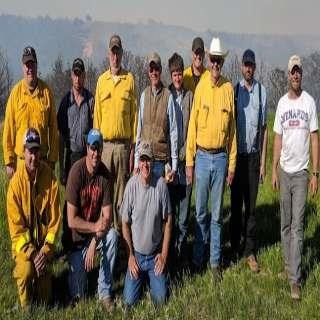Tom Hausmann, in brown vest, gives a briefing before the burn, while Greg Schmitz, in the foreground in a brown jacket, listens with the rest of the burn crew.
The Mid-Missouri River Prescribed Burn Association (MMRPBA) is a non-profit 501(c)(3) organization that facilitates the control of cedar tree encroachment on grasslands in South Dakota’s Brule, Charles Mix, Gregory and Lyman counties. If cedar trees are a primary renovation concern, the process of ridding pastures of cedar trees is also long-term, taking up to two or three years for planning and execution just for the initial burn.
First, if the shearing/burning of cedar trees is a viable option in heavily populated cedar tree areas, the owner and renter need to discuss the risks and complications of such an action, especially if the areas are in rough terrain. The renter needs to recognize the possible need for deferred grazing, the need to create or improve trails within the burn area, the marking of dangerous or difficult areas to travel within the burn area, and the likely clean-up needs after the burn is completed – since a good share of this work may become his/her responsibility.

It takes a good-sized crew for a successful prescribed burn. This crew gathered after the burn on Hausmann’s land. Tom is in the front row kneeling (wearing the grey t-shirt), while Greg, who rents the land that was burned, is standing directly behind him.
Second, the owner and renter need to discuss and plan the actual process itself: Descriptions of the specific areas to be burned, what local personnel might be able to help with the actual burn, access of safety equipment in case of an emergency, and the utilization of natural fire breaks, like roads and waterways, among other criteria. In some cases, conferring with neighbors who also have a cedar tree problem and are interested in burning may simplify some of these considerations. Sometimes burning a larger landscape provides more natural firebreaks and solves access issues within the burn area and for safety equipment and other concerns.
Finally, both the owner and renter need to take advantage of the knowledge and experiences of the MMRPBA. Ideally, both owners and renters would attend burn association meetings and get involved in conversations with others who are planning or have already implemented burns. The owner and renter need to participate in several burns, particularly in terrain like theirs. They need to observe up-close how the ignition team works together and notice what preparations and equipment are on hand for fire suppression and other key functions in the process. They also need to take notes and discuss how they can apply what they have experienced and learned.
As successful MMRPBA burns since 2017 have indicated, the shearing/burning of cedar trees have been effective and are practical methods of beginning or continuing the process of pasture improvement—through participation and involvement of both the owners and the renters.
Source : sdstate.edu